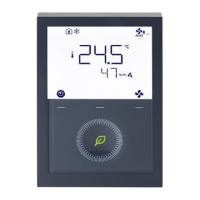The Comfort setpoint w (e.g., customer setting on the display) and the current
setpoint w2 (used by the thermostat for temperature control, but not displayed) are
handled differently depending on the selected application and setting.
Both the Comfort setpoint w and current setpoint w2 have the same value.
The Comfort setpoint w (value selectable by e.g., rotary knob) is in the middle of
the dead zone (P055). The current setpoints w2.. (used by the thermostat for
temperature control) are at the boundaries of the dead zone.
w2h = Comfort setpoint (w) – ½ dead zone (X
dz
)
w2c = Comfort setpoint (w) + ½ dead zone (X
dz
)
● The supported communication objects are different in LTE-Mode and S-Mode
● Changes via the local HMI or tools have the same priority (the last option is
always used)
● Setting the Comfort basic setpoint resets the runtime Comfort setpoint only
when P103 = 0
● Central setpoint shifting is used for summer/winter compensation in particular
● Setpoint shifting does not influence the setpoints stored in P011, P019, P020
and P055
● Local and central shifts are added up
● Applies only to Comfort and Economy setpoints; Protection setpoints are not
shifted centrally
● The current setpoint heating and cooling is limited by the Protection setpoint. If
the Protection setpoint is Off, both the minimum 5 °C and maximum 40 °C are
used
● The current setpoints for cooling and heating of the same operating mode have
a minimum distance of 0.5 K
● The result of local and central shifting, together with room operating mode,
humidity control or setpoint tracking for cooling, is used by the thermostat for
temperature control (current setpoint)
● The room thermostat always takes over the setpoints received from the
controller RMB795B. Thus, the setpoints adjusted locally on the thermostats
are overridden by the setpoints from the room group (e.g., every 15 minutes)
– On RMB, the circumstances under which the controller sends out the
setpoints can be defined. Refer to CE1P3122 for "Setpoint priority" and
"Setpoint Manager" functions

